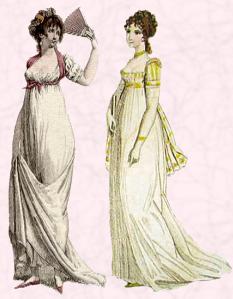Draping:
Long time ago, in Greece, the ladies' garment differs little from the men's wear. Its name is indumentum. It is a traditional clothes that Clothing from under is the tunic which was made up of two bent wool parts, sparing passages for the head and the arms. This tunic is long and can go down to the heels. Anyway, it is a very basic style of draping in the past.
Left - Dress of 1799 Le Journal Des Dames et Des Modes 1799.
Right - Dress of 1800 The Lady's Monthly Museum 1800.
This is Empire Line dress. The fabric for Empire line dresses was usually fine white lawn, muslin or batiste. The white draping style was a sign of social status at that time.
The time can be back to 14th century. The style is from Indian. Its name is Sari. Sari is designed through a flat fabric that is wrapped, draped, and pleated to form a garment.
"The history of Indian clothing trace the sari back to the Indus Valley Civilization, which flourished during 2800-1800 BCE around the western part of the Indian subcontinent"(by Wikipedia)
Tailoring:
This clothing style is in the middle of 17th century. It is a elegant style that women wore a tailored coat with a petticoat and a hat.
The clothes is in 16th Century. It was called "Jerkin". We can see the pattern of which it has been cut to fit the wearer. It is Spanish Brown silk voided velvet trimmed with metallic bobbin lace. It is a historical tailored garment.
The clothes is in 1950s. There are 2 styles in the tailored dress. Dress has forward shoulder seams with pleats at upper and lower edge of bodice front. It is sort of like a trench coat.





No comments:
Post a Comment